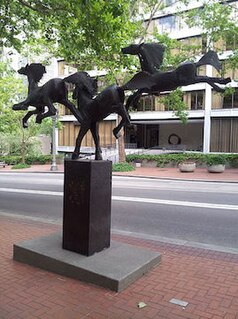
The John F. Kennedy Center for the Performing Arts is the United States National Cultural Center, located on the Potomac River in Washington, D.C. It was named in 1964 as a memorial to assassinated President John F. Kennedy. Opened on September 8, 1971, the center hosts many different genres of performance art, such as theater, dance, orchestras, jazz, pop, and folk music.

Rocinante is Don Quixote's horse in the two-part 1605/1615 novel Don Quixote by Miguel de Cervantes. In many ways, Rocinante is not only Don Quixote's horse, but also his double; like Don Quixote, he is awkward, past his prime, and engaged in a task beyond his capacities.

The Uncle Sam Memorial Statue is a statue commemorating Samuel Wilson, perhaps the original Uncle Sam, near his birthplace in the center of Arlington, Massachusetts, United States. It was sculpted by Theodore Cotillo Barbarossa. It is located on Mystic Street, across from the Cyrus Dallin Art Museum, and adjacent to the Minuteman Bikeway.
A series of Statues of the Liberators of western-hemisphere countries from colonial rule is found along Virginia Avenue, N.W., in Washington, D.C..

Major General James B. McPherson is a public artwork by American artist Louis Rebisso, located at McPherson Square in Washington, D.C., United States. Major General James B. McPherson was originally surveyed as part of the Smithsonian's Save Outdoor Sculpture! survey in 1993. The monument is a bronze equestrian statue of Civil War hero James B. McPherson. The statue is a contributing monument to the Civil War Monuments in Washington, DC, of the National Register of Historic Places.

Benito Juárez is the title of a work of art by Enrique Alciati, located at the intersection of Virginia Avenue and New Hampshire Avenue in Washington, District of Columbia, United States. The statue is a part of the city's Statues of the Liberators collection and is a tribute to former president of Mexico, Benito Juárez.

The Quest, sometimes referred to as Saturday Night at the Y or Three Groins in a Fountain, is an outdoor marble sculpture and fountain designed by Count Alexander von Svoboda, located in Portland, Oregon in the United States. The sculpture, carved in Italy from a single 200-ton block of white Pentelic marble quarried in Greece, was commissioned by Georgia-Pacific in 1967 and installed in front of the Standard Insurance Center in 1970. It depicts five nude figures, including three females, one male and one child. According to the artist, the subjects represent man's eternal search for brotherhood and enlightenment.

Running Horses is an outdoor 1986 bronze sculpture by Tom Hardy, located on the Transit Mall in downtown Portland, Oregon. It is part of the City of Portland and Multnomah County Public Art Collection courtesy of the Regional Arts & Culture Council.

Trigger 4, also known as Trigger Four, is an outdoor 1979 steel sculpture by Lee Kelly, located on the Reed College campus in Portland, Oregon.

Ventana al Pacifico is an outdoor 1989 marble sculpture by Manuel Neri, located outside of the Gus J. Solomon United States Courthouse in downtown Portland, Oregon.

Covered Wagon, also known as Oregon Trail Immigrants Memorial and Pioneer Family, is an outdoor 1934 white marble sculpture by Leo Friedlander installed outside the Oregon State Capitol in Salem, Oregon, United States.

Hatfield Fountain, formally the Antoinette and Mark O. Hatfield Fountain and nicknamed "Chicken Fountain", is an outdoor 1989 fountain and sculpture by Tom Hardy, Lawrence Halprin, and Scott Stickney, installed at Willamette University in Salem, Oregon, United States.

Untitled is an outdoor 1952 fountain and sculpture by Tom Hardy, installed at the Park Blocks in Eugene, Oregon, United States.

Untitled is an outdoor 1975 sculpture by Lee Kelly, installed at Louisa Boren Park in Seattle, Washington, in the United States. The abstract, welded Cor-Ten steel piece measures approximately 19 feet (5.8 m) x 14 feet (4.3 m) x 10 feet (3.0 m). It was surveyed and deemed "treatment needed" by the Smithsonian Institution's "Save Outdoor Sculpture!" program in November 1994. The work is part of the Seattle One Percent for Art Collection and administered by the Seattle Arts Commission.

To Honor the Immigrants is an outdoor 1991–1992 bronze sculpture by Gary Ross, installed at Columbus, Ohio's Battelle Riverfront Park, in the United States.

Temple Bell, also known as Japanese Temple Bell, is a bell and bronze sculpture by Suzuki Magoemon, installed in Boston's Back Bay Fens, in the U.S. state of Massachusetts. Cast in 1675, the bell was originally installed in Manpukuji Temple, in Sendai, Japan, before being salvaged by USS Boston sailors. It was presented to the City of Boston by the sailors in 1945, before being officially presented by Japan as a symbol of peace in 1953. The bell was also previously installed in Boston Common.

George Washington is an outdoor equestrian statue by the Scottish-American sculptor J. Massey Rhind located in Washington Park in Newark, New Jersey. It depicts General George Washington saying farewell to the troops of the Continental Army on November 2, 1783, and was dedicated on the anniversary of that event in 1912.

















